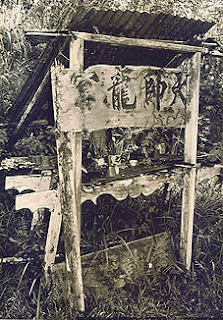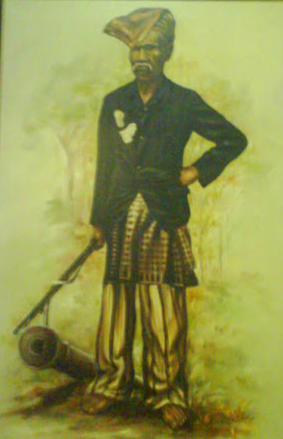HEROES OF SARAWAK
RENTAP
Sarawak was once a ruled country by the Sultan of Brunei, but have been given to James Brooke for his service and he than expand his empire. Back then, life was hard and not a place where we dream of living. people in Sarawak then realise that they want Freedom and Justice. But the most is what they want is INDEPENDENCE. As the time flow, one by one have rise and this is their story.
RENTAP
The Iban chief of Bukit Sadong fame
His original name was Libau but well-known by his short praise-name (ensumbar in Iban) Rentap. He was a Dayak (Iban) rebel leader in Sarawak, Malaysia during the Brooke White Rajah era. This made him the hero for the Iban Dayak in the State of Sarawak, Malaysia, located at the western part of the Borneo Island. "Rentap" in Iban means the "World-shaker". He was proclaimed by his followers as "Raja Darat" (King of Land) or "Raja Ulu" (King of Upriver) at the height of his power at his Sadok Hill fort. Rentap became well-known when he was selected to be one of the leading fighting men for a great war leader, Orang Kaya Pemancha Dana "Bayang" who led war expeditions to the areas around the mouth of Kapuas River in West Kalimantan, Indonesia. This by chance prepared the young warrior Rentap with war experience in fighting James Brooke later on in his life especially at Sadok Hill until his death in hiding in 1870.

Timpang Brang, or the one armed cannon used by Rentap's forces to defend the fort on Bukit Sadok

This cannon ball was found recently when the longhouse was moved, it is to big to have come from the cannon used by Rentap, most likely it would have come from the "Bujang Sadok" that is the 12 pound cannon brought to the mountain by the Brooke forces.

Replica of Rentap's cannon standing on top of the mountain.
ROSLI DHOBI
who assasinated the second British governor Sir Duncan Stewart in 1949.
Rosli Dhobi was born in 1932 in Kampung Siong, Sibu, Kingdom of Sarawak. Rosli started his career as a teacher and quit his job in 1947 in order to teach in Sibu People's School. Rosli was known to be a nationalist and a poet. Using the nickname Lidros, Rosli penned down a nationalistic poem titled 'Panggilan Mu yang Suchi' which was published in Utusan Sarawak on February 28, 1948. The usage of nickname was prevalent at the time since the British Colonial Authority vigorously monitored any attempts to spread words against them. Rosli joined Rukun 13 in August, 1948. He was introduced to the organization by an old friend, Bujang Suntong. It was a secret cell organization, composed of nationalists and patriots, which carried out assassinations of officers of the British Colonizer in Sarawak. He was well known for his assassination of Sir Duncan George Stewart, the second governor of colonial Sarawak in 1948. After a few months languishing in prison, Rosli Dhoby, Awang Ramli Amit Mohd Deli, Morshidi Sidek and Bujang Suntong were found guilty of murder and sentenced to death on December 4, 1949.

MAKAM ROSLI DHOBI
SHARIF MASAHOR
The melanau warrior
Sharif Masahor was also known as Sayyid Mashhur bin Muhammad Al-Shahab. Before the arrival of James Brooke, he was a powerful member who ruled and, in the past, like Datu Patinggi Abdul Gapur, he was very influential and respected due to both his charisma in uniting the people of different races and beliefs, and also due to his lineage. James Brooke's expansion policy caused disturbance in many parts of Borneo. Brooke's encroachment into local leaders' territory caused many locals to rebel, including Syarif Masahor. In July 1859, Masahor and his army attacked Brooke's outpost near Bukit Rejang in Kanowit. During this attack, officers Charles Fox and Henry Steele were killed by Melanau people led by Sawing and Sakalai. This angered the British people throughout Kuching following the rebellion by the Chinese people. In early 1860, Masahor ordered Temenggung Hayim Jalil from Brunei to go to Pontianak for a meeting with Abdul Gapur. In early February 1860 they mounted an assault on Kuching (at that time, Sarawak), according to Masahor's plan. Masahor and his army wanted to approach Kuching via the Sarawak River. In the battle that ensued, the British forces gained the upper hand when Charles Brooke succeeded in ambushing and destroying all Masahor's ships. Facing defeat, Masahor retreated to Brunei, where he would seek shelter from the British. However, in 1861, James Brooke went to Brunei, in hopes of forcing the Sultan of Brunei to banish Syarif Masahor to Selangor once and for all. Masahor eventually arrived at Klang, where he became an adviser to Sultan Abdul Samad. During the Klang War however, Syarif Masahor sided with the rebellious Klang territorial chief Raja Mahadi who did not recognise Sultan Abdul Samad's rule. Abdul Samad sought British help to win the war, and Masahor ended up fighting against the British for a second time. Nevertheless, after the surrender of Raja Mahadi and Syarif Masahor, they were both pardoned by Abdul Samad. Syarif Masahor died in Kerling, Selangor in 1890 and was buried there.
LIU SHAN BANG
leader of the 1857 Chinese Uprising
The reforming Brooke administration had angered the Bau(part of Sarawak) miners & the Twelve Kongsi, and thus a rebellion was started against the White Rajah. The rebellion was initiated in 1857 at Tian Tsze Lung Kung in Bau by Liu Shan Bang, the leader of the Twelve Kongsi. 600 armed miners, without proper weapons & military training, paddled down the Sarawak River & attacked the Astana. James Brooke escaped the assault. Five Europeans were killed, and one was mistaken to be James Brooke. With no political will & planning the Chinese miners stayed or ruled Kuching for 3 days before returning to their base. By then, James Brooke had already been given time for retaliation. The counter attacks by Brooke’s army, with combined forces of Skrang Iban warriors & Malays loyal to him, defeated the Chinese miners badly. In Jugan Siniawan, more than a hundred miners were killed; including the leader Liu Shan Bang himself.
A memorial monument for the local hero, Liu Shan Bang, during the 1857 Chinese Insurrecti
Notes on the history of the hero, Liu Shan Bang, the Twelve Kongsi, the Bau gold mining, and the 1857 incident. It was believed that the Twelve Kongsi actually ruled Sarawak for 3 days before the Brooke Administra

The remains of the old Tian Tsze Lung Kung, photo taken in the 1970s. Source: Internatio
DATUK PATINGGI ALI
Datuk Patinggi Ali was a principal leader of the Sarawak Malays who fought against the Brunei Government during the rule of Pengiran Makota and Raja Muda Hasim, most probably between 1837 and 1840. He surrendered in December, 1840 on the understanding that James Brooke would hence forth become the Raja and stop the Brunei Pengirans from oppressing them.After James Brooke was declared Raja and the Governor of Sarawak on 24th.September, 1841 and he reinstated Datu Patinggi Ali as a leader of the Sarawak Malays. From 1841 to 1844 he served James Brooke as a famous fighting man for the government.




No comments:
Post a Comment